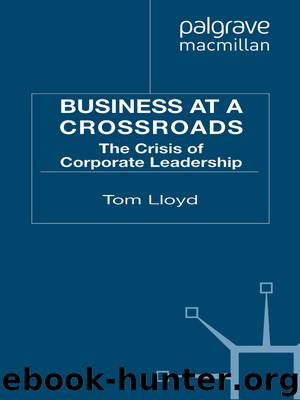Business at a Crossroads by Tom Lloyd

Author:Tom Lloyd
Language: eng
Format: epub
Publisher: Palgrave Macmillan
Published: 2009-12-31T16:00:00+00:00
The cult of leadership
If we reject greed as an adequate explanation for excessive levels of CEO pay, and we accept asset-skimming as a form of remuneration unconstrained by a link to value added or time spent working, our explanation so far for the high absolute levels of executive pay consists of two components.
The first is the inferences drawn, by management theorists, Remcos and the investment community, about executive rewards from the new shareholder value performance standard. The second is the lack of opposition to “the sky's the limit” pay packets from the investors who pay them, which may itself be a consequence of the integration of investment banking and fund management under one corporate roof and the impact this has had on the willingness of fund managers to object to such pay packets.
This is consistent with the description of the CEO market provided by Harvard Business School professor, Rakesh Khurana, in his brave book – it is dangerous to bite the hand that feeds you consultancy work – Searching for a Corporate Savior.6
Khurana argues that the market for “external” CEOs – as opposed to CEOs appointed from within the company – is not a “market” at all, in the neoclassical sense, where large numbers of transactions set the equilibrium price, no single transaction influences the market as a whole and perfect competition between applicants for jobs and employers for applicants guarantees both parties the market price. He says the CEO market is a social construction (witness all those conflicts of interests and of interest and duty). It's “closed” in Max Weber's sense,7 in that CEO positions at large, listed U.S. and U.K. companies are only open to people “who fit certain socially defined criteria.”
Three common “social matching” criteria when a board is drawing up a list of candidates for the CEO job are: the current position of the candidate, and the performance and stature of the candidate's company. These automatically exclude from the candidates’ pool the good people who just miss the cut as far as rank is concerned, the good people who work for currently underperforming companies, and the good people who work for smaller, less illustrious companies.
When thinning down the long list of those who satisfy these rather arbitrary tests, the most important criterion for elevation to the short list is the requirement that the candidates are superstars.
Khurana argues that Alfred Chandler's “managerial capitalism” (see Chapter 3) was replaced by what he calls “investor capitalism” in the late 1970s, after the markets of large American companies were successfully attacked by more efficient European and Asian (mostly Japanese) companies. Previously supine investors demanded action, and it soon became apparent that the action most likely to appease them was the appointment of a high-profile “leader,” unencumbered by allegiance to the past or the status quo, and capable of taking the drastic action needed to see off the foreign invaders.
It was unfortunate that the merits of this half-baked theory, that all that was needed to revive an ailing company was a
Download
This site does not store any files on its server. We only index and link to content provided by other sites. Please contact the content providers to delete copyright contents if any and email us, we'll remove relevant links or contents immediately.
The Brazilian Economy since the Great Financial Crisis of 20072008 by Philip Arestis Carolina Troncoso Baltar & Daniela Magalhães Prates(117465)
International Integration of the Brazilian Economy by Elias C. Grivoyannis(87285)
The Art of Coaching by Elena Aguilar(52864)
Flexible Working by Dale Gemma;(23238)
How to Stop Living Paycheck to Paycheck by Avery Breyer(19613)
The Acquirer's Multiple: How the Billionaire Contrarians of Deep Value Beat the Market by Tobias Carlisle(12203)
Thinking, Fast and Slow by Kahneman Daniel(12004)
The Radium Girls by Kate Moore(11886)
The Art of Thinking Clearly by Rolf Dobelli(10166)
Hit Refresh by Satya Nadella(9010)
The Compound Effect by Darren Hardy(8758)
Tools of Titans by Timothy Ferriss(8176)
Atomic Habits: Tiny Changes, Remarkable Results by James Clear(8140)
Turbulence by E. J. Noyes(7913)
Change Your Questions, Change Your Life by Marilee Adams(7588)
A Court of Wings and Ruin by Sarah J. Maas(7587)
Nudge - Improving Decisions about Health, Wealth, and Happiness by Thaler Sunstein(7497)
How to Be a Bawse: A Guide to Conquering Life by Lilly Singh(7358)
Win Bigly by Scott Adams(7056)
